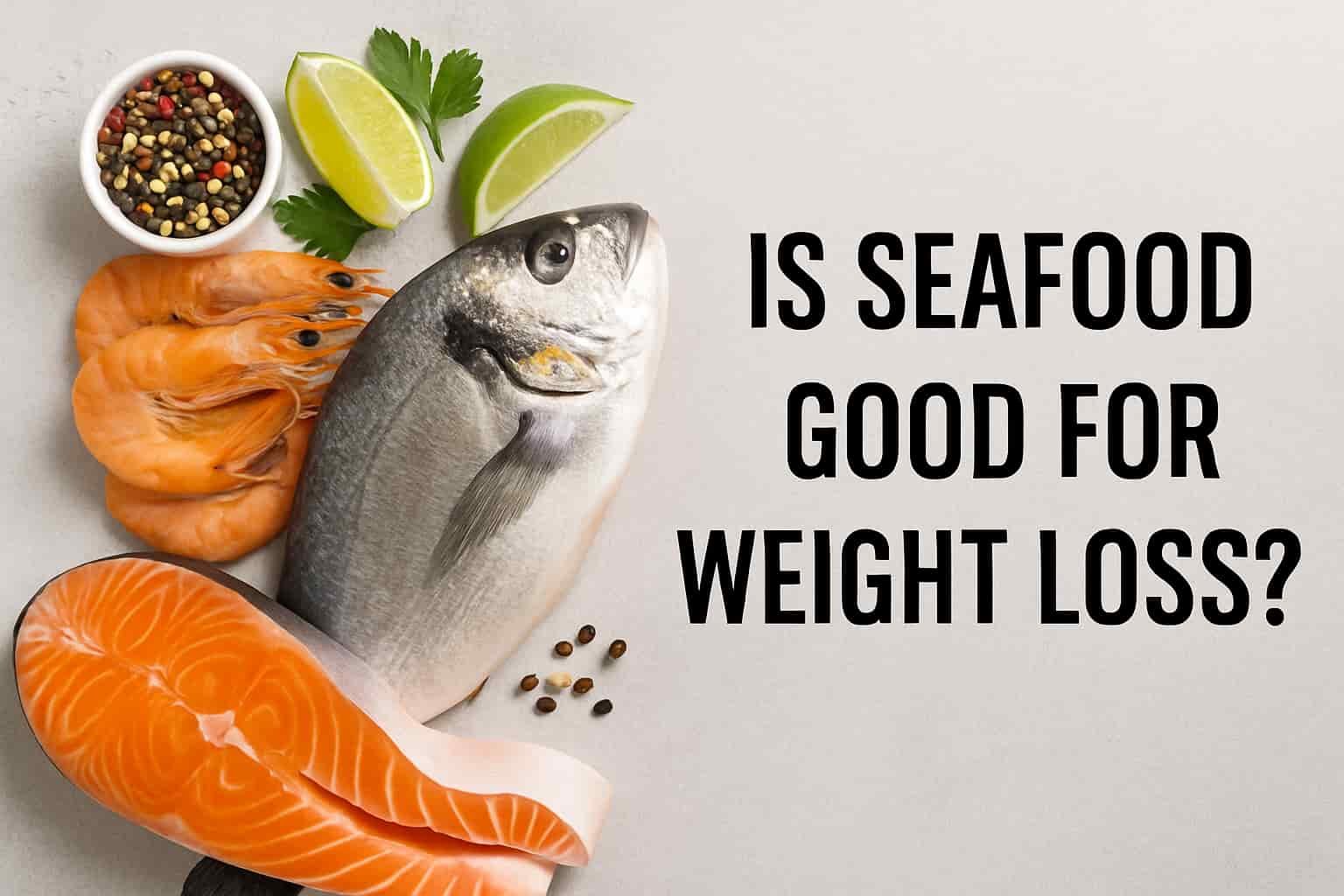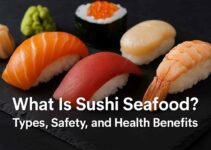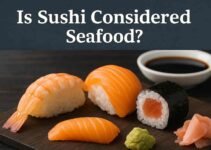Losing weight effectively depends on maintaining a calorie deficit while ensuring proper nutrition. Seafood plays a critical role in this process because it offers high-quality protein, essential nutrients, and healthy fats with relatively low calorie content. Unlike many other protein sources, seafood delivers bioavailable nutrients such as iodine, vitamin D, and omega-3 fatty acids, which directly support metabolic health.
This article answers a common question: Is seafood good for weight loss? You will discover precise nutritional facts, learn which seafood options provide the greatest benefits, and understand how to integrate seafood into your diet to achieve sustainable fat loss results.
Contents
- 1 Why Do People Consider Seafood for Weight Loss?
- 2 What Types of Seafood Are Best for Supporting Weight Loss?
- 3 How Does Cooking Method Affect the Weight Loss Benefits of Seafood?
- 4 Can Eating Seafood Accelerate Fat Burning and Metabolism?
- 5 How Often Should You Eat Seafood for Effective Weight Loss?
- 6 Are There Any Risks of Eating Too Much Seafood While Dieting?
- 7 What Are Practical Meal Ideas Incorporating Seafood for Weight Loss?
- 8 Is a Seafood-Only Diet Sustainable for Long-Term Weight Management?
Why Do People Consider Seafood for Weight Loss?
Seafood is considered effective for weight loss because it provides high protein content, essential fatty acids, and low calorie density compared to other animal-based proteins.
- Protein content increases satiety and reduces hunger signals. A 2021 study published in The Journal of Nutrition found that individuals consuming 30% of their daily calories from protein experienced a 25% reduction in overall calorie intake.
- Omega-3 fatty acids directly support fat metabolism. Research from the International Journal of Obesity confirms that consuming 1.5 grams of omega-3 daily increases fat oxidation by 10% during moderate-intensity exercise.
Seafood also offers critical micronutrients like iodine, which supports thyroid hormone production and metabolic rate regulation. Learn more in our detailed guide on seafood nutrition facts.
How Does High-Protein Seafood Influence Satiety and Calorie Intake?
High-protein seafood increases satiety by elevating the production of satiety hormones such as peptide YY and GLP-1, leading to a measurable reduction in calorie consumption.
- A controlled trial by the American Journal of Clinical Nutrition showed that participants consuming 200 grams of cod daily reported a 12% lower calorie intake at their next meal.
- The thermic effect of protein (TEF) is approximately 20–30%, meaning your body burns 20–30% of protein calories during digestion.
Examples of high-protein, low-fat seafood include cod, haddock, and shrimp. These options contain between 18–24 grams of protein per 100 grams and less than 2 grams of fat.
Does the Fat Content in Seafood Affect Weight Loss Efforts?
Fat content in seafood positively affects weight loss when sourced from healthy fats like omega-3, which promote fat oxidation and reduce abdominal fat accumulation.
- Fatty fish such as salmon and mackerel contain up to 2.2 grams of omega-3 per 100 grams.
- A meta-analysis published in Nutrition Reviews found that daily intake of omega-3 reduced waist circumference by an average of 0.5 cm over eight weeks.
However, portion control is essential. A standard 100-gram serving of salmon contains approximately 206 calories, while the same amount of cod provides only 82 calories. For individuals targeting fast weight reduction, prioritize lean fish while incorporating fatty fish 2–3 times weekly for metabolic benefits.
What Types of Seafood Are Best for Supporting Weight Loss?
Seafood options best suited for weight loss are those high in protein and low in unhealthy fats and calories. Selecting the right types of seafood ensures nutrient density without contributing excess calories to your diet.
- Lean seafood options like cod, tilapia, shrimp, and scallops provide 18–24 grams of protein per 100 grams with less than 100 calories.
- Fatty fish like salmon, mackerel, and sardines supply essential omega-3 fatty acids beneficial for fat metabolism, despite their higher calorie content.
Balancing both types of seafood in your meal plan maximizes nutritional benefits while supporting weight management goals.
Which Low-Calorie Seafood Options Should You Choose?
The best low-calorie seafood options for weight loss include cod, tilapia, shrimp, and scallops due to their high protein and minimal fat content.
- Cod: 82 calories and 18 grams of protein per 100 grams.
- Tilapia: 96 calories and 20 grams of protein per 100 grams.
- Shrimp: 99 calories and 24 grams of protein per 100 grams.
- Scallops: 88 calories and 20 grams of protein per 100 grams.
These seafood options deliver essential amino acids required for muscle maintenance and metabolic efficiency without contributing excessive calories.
Are Fatty Fish Like Salmon and Mackerel Suitable for Weight Loss?
Fatty fish such as salmon and mackerel are suitable for weight loss because their high omega-3 content improves fat oxidation and reduces inflammation, which supports metabolic health.
- Salmon: 206 calories and 2.2 grams of omega-3 per 100 grams.
- Mackerel: 205 calories and 2.5 grams of omega-3 per 100 grams.
A clinical study published in Obesity Research found that participants consuming fatty fish three times per week experienced a 1.1% greater reduction in body fat percentage compared to those avoiding fatty fish. However, limit portions to 100–150 grams per serving to avoid calorie surplus while maximizing omega-3 intake.
How Does Cooking Method Affect the Weight Loss Benefits of Seafood?
Cooking methods significantly influence the calorie content and nutritional retention of seafood, directly impacting its effectiveness for weight loss. Methods that require minimal added fats preserve the natural low-calorie advantage of seafood, while high-fat cooking methods add unnecessary calories.
- Steaming and grilling preserve nutrient density without adding extra calories.
- Frying can increase the calorie content of seafood by over 50% per serving.
Choosing the right preparation method ensures that seafood remains a lean, high-protein option that supports fat loss effectively.
Which Cooking Methods Preserve the Most Nutrients for Weight Loss?
Steaming, grilling, and baking are the best cooking methods for preserving nutrients and maintaining the low-calorie profile of seafood.
- Steaming retains up to 95% of water-soluble vitamins like B12 and preserves protein quality.
- Grilling enhances flavor without requiring added oils, keeping calorie content low.
- Baking at moderate temperatures (around 180°C or 356°F) minimizes nutrient loss and prevents the formation of harmful compounds found in high-heat frying.
Avoid deep-frying and pan-frying with excessive oils, as they can add 150–300 extra calories per serving, negating the natural weight loss benefits of seafood.
Should You Avoid Certain Sauces and Side Dishes with Seafood?
Yes, high-calorie sauces and carb-heavy side dishes can undermine the weight loss benefits of seafood.
- Avoid creamy sauces like tartar and mayonnaise-based dressings, which add up to 150 calories per tablespoon.
- Steer clear of high-carb sides such as buttered rice or mashed potatoes that contribute unnecessary calories.
Recommended alternatives include:
- Lemon juice and fresh herbs for flavor enhancement without added calories.
- Vinegar-based dressings, such as balsamic vinaigrette, to complement seafood dishes while keeping calorie counts low.
- Steamed vegetables and fresh salads to add volume and fiber, promoting satiety and better digestion.
Can Eating Seafood Accelerate Fat Burning and Metabolism?
Seafood accelerates fat burning and boosts metabolism by providing essential nutrients such as iodine, selenium, and omega-3 fatty acids that directly support metabolic functions.
- Iodine regulates thyroid hormone production, which controls metabolic rate. A deficiency in iodine reduces metabolism by up to 20%, according to research from the American Thyroid Association.
- Omega-3 fatty acids increase the rate of fat oxidation. A meta-analysis published in The Journal of Nutrition found that consuming 1.5 grams of omega-3 daily elevated resting metabolic rate by 5%.
- Selenium, found abundantly in shellfish, enhances thyroid function and prevents metabolic slowdowns.
Including seafood in your diet at least 3–4 times per week ensures optimal intake of these critical nutrients for sustained fat burning and energy expenditure.
How Often Should You Eat Seafood for Effective Weight Loss?
To support effective weight loss, consume seafood at least 3 to 5 times per week, ensuring a balance between lean and fatty fish varieties.
- The American Heart Association recommends eating at least two servings of fatty fish weekly for cardiovascular and metabolic health.
- For faster weight reduction, include lean seafood like cod or shrimp in up to five meals per week to maximize protein intake without excess calories.
Balanced consumption plan:
- 2 servings of fatty fish (salmon, mackerel) for omega-3 benefits.
- 3 servings of lean fish or shellfish (cod, shrimp, scallops) for high protein and low-calorie intake.
Are There Any Risks of Eating Too Much Seafood While Dieting?
Excessive seafood consumption may introduce health risks related to mercury exposure and nutrient imbalances.
- Mercury accumulation is a concern with high consumption of large predatory fish such as tuna, swordfish, and king mackerel. The FDA advises limiting these to one serving per week.
- Overconsumption of selenium-rich shellfish may lead to selenium toxicity if daily intake consistently exceeds 400 mcg, although this is rare.
Safe consumption guidelines:
- Stick to a maximum of 340 grams (12 ounces) of low-mercury seafood per week.
- Rotate seafood types to minimize exposure to heavy metals and ensure a diverse nutrient profile.
What Are Practical Meal Ideas Incorporating Seafood for Weight Loss?
Incorporating seafood into your weight loss diet is simple with balanced, nutrient-dense recipes that are low in calories and high in protein.
Quick and Healthy Seafood Recipes for Busy Days
- Grilled Shrimp Salad: 150 grams of grilled shrimp served over mixed greens with cherry tomatoes, cucumbers, and a light balsamic vinaigrette. Total calories: 280 kcal, protein: 32 grams.
- Steamed Cod with Vegetables: 200 grams of cod steamed with broccoli, carrots, and a squeeze of lemon. Total calories: 250 kcal, protein: 40 grams.
- Salmon Bowl: 100 grams of grilled salmon over quinoa with steamed spinach and avocado slices. Total calories: 400 kcal, rich in omega-3s.
These meals take under 20 minutes to prepare and provide balanced macronutrients, supporting weight loss without compromising flavor or satisfaction.
Budget-Friendly Seafood Options for Weight Loss
Affordable seafood choices help maintain a weight-loss-friendly diet without increasing grocery expenses.
- Frozen white fish fillets like cod and pollock are often cheaper while retaining nutritional value.
- Canned tuna and sardines in water offer high protein and omega-3 at a lower cost.
- Frozen shrimp provides convenience and cost savings, often priced lower than fresh varieties.
Buying in bulk and choosing frozen options reduces waste and ensures a consistent supply of high-quality protein for your diet.
Is a Seafood-Only Diet Sustainable for Long-Term Weight Management?
A seafood-only diet is not sustainable for long-term weight management because it lacks sufficient dietary diversity required for complete nutrition.
- Nutrient deficiencies: Over-reliance on seafood can result in inadequate intake of fiber, certain vitamins (like vitamin C and K), and phytonutrients found in plant-based foods.
- Caloric limitations: Strict seafood-based diets may create extreme calorie deficits, leading to metabolic slowdown and muscle loss over time.
For sustainable weight management, integrate seafood as a primary protein source while including a variety of vegetables, whole grains, and healthy fats. This balanced approach ensures nutrient adequacy and long-term adherence to a healthy lifestyle.



